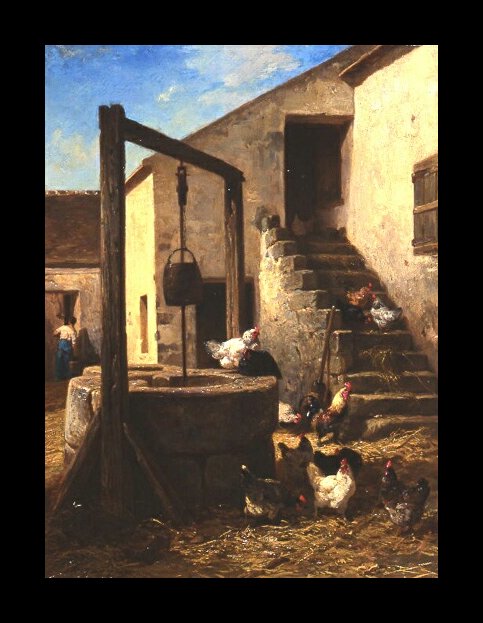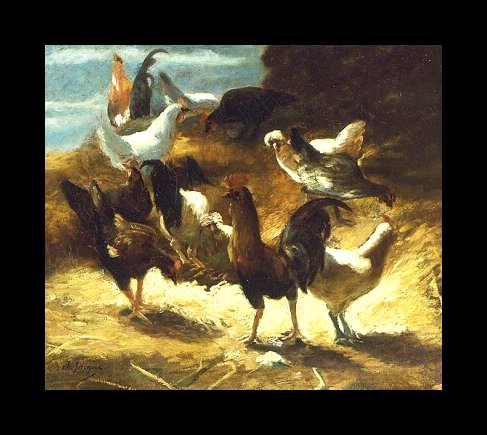Charles Emile Jacque (1813-1894)
Get a Jacque Certificate of Authenticity for your painting or a COA for your Boucher drawing or print.
For all your Jacque artworks you need a Certificate of Authenticity in order to sell, to insure or to donate for a tax deduction.
How to get a Jacque Certificate of Authenticity is easy. Just send us photos and dimensions and tell us what you know about the origin or history of your Jacque painting, drawing or print.
If you want to sell your Jacque painting, drawing or print use our selling services. We offer Jacque selling help, selling advice, private treaty sales and full brokerage.
We have been authenticating Jacque and issuing certificates of authenticity since 2002. We are recognized Jacque experts and Jacque certified appraisers. We issue COAs and appraisals for all Jacque artworks.
Our Jacque paintings, drawings and print authentications are accepted and respected worlwide.
Each COA is backed by in-depth research and analysis authentication reports.
The Jacque certificates of authenticity we issue are based on solid, reliable and fully referenced art investigations, authentication research, analytical work and forensic studies.
We are available to examine your Jacque painting, drawing or print anywhere in the world.
You will generally receive your certificates of authenticity and authentication report within two weeks. Some complicated cases with difficult to research Jacque paintings or drawings take longer.
Our clients include Jacque collectors, investors, tax authorities, insurance adjusters, appraisers, valuers, auctioneers, Federal agencies and many law firms.
We perform Charles Emile Jacque art authentication, appraisal, certificates of authenticity (COA), analysis, research, scientific tests, full art authentications. We will help you sell your Charles Emile Jacque or we will sell it for you.


Charles Emile Jacque must be undoubtedly one of the most interesting members of the Barbizon School. He produced paintings, lithographs, engravings and etchings and had both a colourful life and artistic career. Not only was he a very successful painter, he also produced caricatures for leading satirical magazines of the day, ran a chicken farm and contributed articles to an agricultural journal!
Jacque was born in Paris and initially worked in the office of a notary. He was then apprenticed to a cartographer, but he easily became bored simply tracing lines and maps all day. He went to study in the studio of the painter Charles Suisse, but he did not stay there long. His family was not wealthy enough to ‘buy out’ his conscription from the French state, and he was therefore obliged to enlist and spend seven years in the military. Whilst there, he did not let his artistic talents go to waste, and he made sketches of soldiers and the military, which he sold for one franc each.
After the army, Jacque left for England, where he stayed for nearly two years. He practiced the technique of woodcutting and produced wood cuts for illustrations for some works by William Shakespeare.
He then returned to Paris, where he worked as an illustrator and caricaturist. He produced a number of caricatures on the medical profession and doctors of the day. In the 1840s, he began to concentrate on producing original etchings by the Dutch Masters. It was around this time when he became interested in landscapes and rural life. He exhibited an etching in the 1844 Salon of a painting by Theodore Rousseau, and in 1845, he submitted a portrait copied from Rembrandt.
In 1846, he was commissioned to produce an engraving of a work by Prudhorn for the Church of Murat in the Cantal region of France.
Charles Emile Jacque was a friend of the artist Jean Francois Millet, and it was with Millet that he moved to the area around the Forest of Fontainebleau. They both moved there to paint but also to escape the cholera epidemic sweeping through Paris at the time. He very quickly fell in love with the rural way of life there. He painted landscapes but also very quickly started painting barnyard animals. He particularly liked painting sheep, and we only need look at the subject and titles of some of his paintings in museums around the world to see that he had a passion for painting sheep. In the Cleveland Museum of Art, we can see a painting entitled, Shepherdess with Sheep. A painting in the National Gallery of Art in Washington is entitled The Shepherdess, and in the Courtauld Institute of Art in London, there is the painting Landscape with Sheep and Shepherd. The list of paintings of sheep by Charles Emile Jacque goes on and on.
Jacque also had a love of chickens and wrote a book about them as well as contributing articles to agricultural journals of the day. He wrote about diverse topics, such as drainage systems and raising farm animals, and also regularly went to the Jardin des Plantes in Paris where he had permission to draw and study the animals.
Charles Emile Jacque was a very successful artist of the 19th century. His work was bought by American art collectors, and in 1867, he was made a Knight of the Legion of Honour. He also sat on the jury for the Grand Prix de Rome, as well as on the jury for the Exposition Universalle in Paris.
In 1881, he began to experiment with watercolours, and in 1881, a young Camille Pissarro became his student. His two sons also went on to become artists and had a particular interest in animals, like their father.
Take another look at that 19th century painting you have of a flock of sheep, which you may have thought a rather boring subject matter. It is possible that it is by Charles Emile Jacque!



Reviews
1,217 global ratings
5 Star
4 Star
3 Star
2 Star
1 Star
Your evaluation is very important to us. Thank you.
